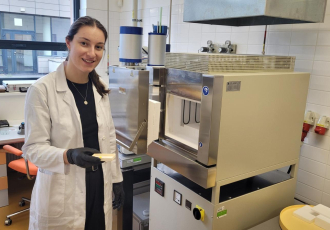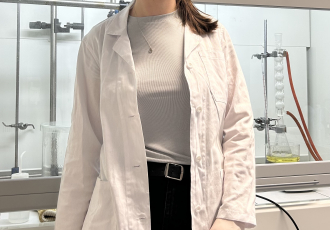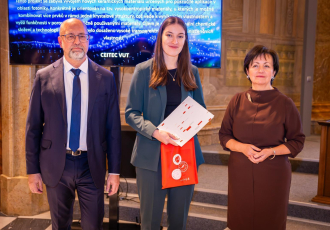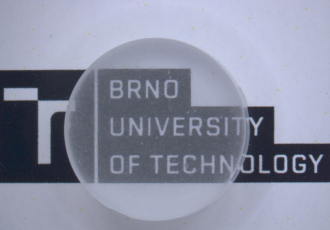16. July 2025
Combining at least five elements into a single crystalline structure to create a transparent ceramic material that more efficiently transmits light beams – that is the goal of the research for which Tereza Havlíková from CEITEC BUT received the prestigious Brno PhD Talent scholarship. Her work opens doors to more efficient lasers, scintillators, and LED technologies.
Tereza Havlíková has been working at CEITEC BUT in the Advanced Multifunctional Ceramics group for three years where she is developing a new type of transparent ceramic material that may be used in optics and photonics. Her aim is to find the optimal composition and technological preparation process for ceramic compounds with maximum transparency and photoluminescence – the ability to emit light after irradiation.
She focuses on so-called high-entropy materials, the use of which in transparent ceramics is still a novelty. "Simply put, it’s about combining multiple elements into a single crystalline structure. A higher number of elements brings greater entropy – or disorder – and thanks to it, the material gains a greater driving force to stabilize even under unusual conditions,” the scientist explains.
While previous studies have shown that such materials can display remarkable mechanical or superconducting properties, it remains to be seen whether they can also offer benefits for optics. “By combining atoms of different sizes, the crystal lattice becomes distorted (deformed), which leads to a shift or change in the shape of the emission spectrum. This can not only improve efficiency in existing technologies but also expand the range of possible applications,” Tereza adds.
Transparent ceramics are used, for example, as a medium for lasers or in lighting technology. They also hold great potential in the field of scintillation detectors, such as those found in X-rays or electron microscopes. “The material can capture X-ray radiation and convert it into the visible spectrum. These are currently the most likely applications, but further possibilities may appear later on,” she says.
Tereza's research focuses on materials with a garnet structure, into which she adds rare-earth ions – elements from the bottom part of the periodic table, little known to the public, but valued for their unique luminescent and magnetic properties. “Each element reacts differently. Some interfere with each other, while others complement one another. The challenge is to find five that won’t conflict and ideally will have a synergistic effect,” she notes.
The scientists is currently working to identify the ideal chemical composition with the best optical properties. Next, it will be crucial to ensure the optical purity of the material. “Any impurities or defects can scatter light and reduce the material’s ability to transmit it,” she explains.
Tereza Havlíková is delighted to have received the Brno PhD Talent scholarship. “Transparent ceramics are very demanding to prepare. It’s a complex process where you need to control every step – from synthesizing chemically pure powder to advanced sintering. It’s a challenge, but that’s exactly what I enjoy about it,” she concludes.
Source: www.zvut.cz


 Share
Share




